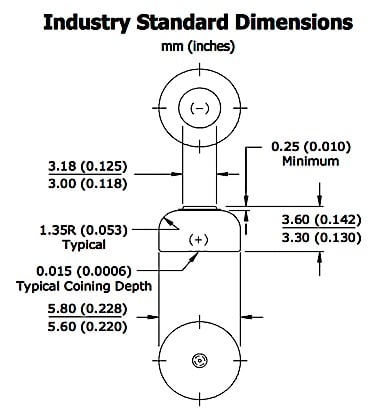Hearing Aid Battery Performance Inspired by Bo Derek?
Recent posts on this site provided a paper trail to the origin of the CIC (completely-in-canal) hearing aid. I was reminded that one component not discussed, but facilitating this movement to small hearing devices, was the hearing aid battery (actually, a cell as it relates to the custom-molded instruments of the time, but the two terms will be used interchangeably in this post).
Prior to about 1986 the only pill-type cells available for hearing aids were those in sizes designated as 13, 312, 675, and 41. All were too large to meet the requirements for continued successful miniaturization of hearing aids. Today, all hearing aid pill-type cells are Zinc-Air (Zn/O2).
However, about 1985, the Starkey hearing aid manufacturing company approached Rayovac Corporation Battery Division to develop a very small cell that could be used to reduce the size of custom-molded hearing aids. This was in keeping with the industry trend to miniaturize hearing aids as much as possible, especially custom-molded products. This request led to the development of the size 10 cell{{1}}[[1]]Tom Begley, Rayovac, personal communication, 12/20/2015[[1]].
Where Do Hearing Aid Cells Get Their Name Designations?
Bo Derek
Where did the designation size 10 come from? The cell was actually named after a movie called “Ten,” starring Bo Derek, according to Begley. It was given the code name 10 during development. When time came to bring it to market, the Rayovac market manager elected to use that as the size designation because he said it was the “perfect size” battery. Just like the movie.
After Rayovac introduced the size 10 cell, Energizer and Duracell developed a same physical-sized cell, but declined to use the size 10 designation because they thought that naming a battery after a movie was somewhat frivolous. They called theirs the size 230.
According to Begley, and John Oltman, a long-time, and retired Rayovac employee who headed their zinc-air development team, the history of battery naming seems to be lost in the fog of history. What follows is based on best recollection from them, and from the author.

Figure 1. Industry standard dimensions (mm and inches) for a size 312 hearing aid cell. It is identified by its maximum width, which is rounded to 0.312 inches.
Why was the designation 230 suggested? This seems to have been suggested to follow a trend established with the introduction and naming of the 312 cell. Figure 1 shows the industry standard dimensions for the size 312 cell. Note that its maximum diameter is posted as 7.90 mm, or 0.311 inches. 0.311 was rounded up to 0.312 and used to identify this cell. It should be noted that there are no ± values for the maximum diameter. It can be no greater than 7.9 mm for the 312 cell. Any variation applies only to reduced diameter allowance, which is designated as being -0.25 mm. This minus allowance holds for all the hearing aid cells.

Figure 2. Industry standard dimensions (mm and inches) for a size 10 hearing aid cell. It is identified by its maximum width, which is rounded to 0.230 inches. However, this cell is commonly identified with the size 10 designation, that attributed to be the perfect shape after Bo Derek of the movie “Ten.”
The same logic appears to have been applied by Energizer and Duracell to provide a designation for what they called the 230 cell (Figure 2). The maximum diameter is 5.8 mm which rounds up to about 0.230 inches, providing the designation as the 230 cell.
However, as the size 10 gained nomenclature acceptance over other small batteries in the market, Energizer, Duracell, and all other battery manufacturers dropped the 230 designation, and the size 10 became the universal designation for this size cell.
The size 5 cell, now essentially discontinued, was so named because it was half the size of the 10.
The size 675 cell designation originated in WWII for the U.S. Army.
No historical information could be found on the designation of the size 13 cell, other than it was the same size as used in the replaced mercury cell.
What is not commonly known is that hearing aid cells also have ANSI (American National Standards Institute) and IEC (International Electrotechnical Commission) designations. These designations, along with typical capacity, color code, and dimensions are provided in Figure 3.

Figure 3. Names, capacities, dimensions (in mm), and color code for the most common hearing aid zinc-air hearing aid cells.
“The Rest of the Story.”
So, for the “rest of the story,” if a size 10 cell is used to power a hearing aid, you might say that it has been “activated” by Bo Derek (watch your mind).






